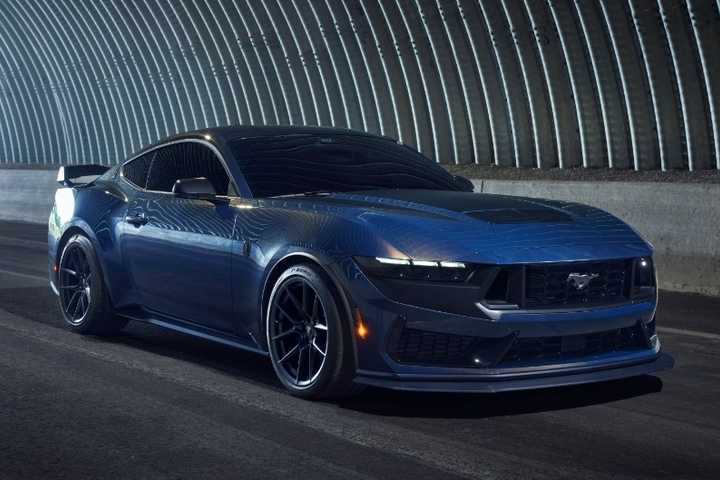RTR Vehicles, a well-known aftermarket tuner of Ford vehicles, has unveiled its newest take on the seventh-generation Mustang. Called the RTR Spec 5, this particularly powerful pony boasts over 870 horsepower and 660 pound-feet of torque. The engine it uses is the same 5.0-liter V8 in the Mustang GT, but a giant 3.0-liter Whipple supercharger, HD Race Intercooler system, and Borla cat-back exhaust unlock an extra 390 horsepower.


- Base Trim Engine
-
5L V8 ICE
- Base Trim Transmission
-
TREMEC 6-speed manual
- Base Trim Drivetrain
-
Rear-Wheel Drive
- Base Trim Horsepower
-
500 HP @5000 RPM
- Base Trim Torque
-
418 lb.-ft. @ 4900 RPM
- Base Trim Fuel Economy (city/highway/combined)
-
14/22/17 MPG
- Base Trim Battery Type
-
Lead acid battery
- Make
-
Ford
- Model
-
Mustang Dark Horse
While it may be a beast on the road and an absolute piece of eye candy, there are other modified Mustangs, as well as a factory-upgraded variant, the Dark Horse, that, in the Dark Horse’s case, costs much less than the very expensive RTR Spec 5. Let’s take a look at some high-powered ponies and determine whether the RTR’s upgrades and abilities are worth the premium over other noteworthy performance variants.
To provide the most accurate and up-to-date information, this article uses data sourced from various manufacturers and authoritative sources.
The RTR Mustang Spec 5 Boasts More Than Just An Upgraded Power Plant
Fortunately, RTR kept modifying the rest of the car so it could keep up with the engine. The Spec 5 has proprietary 30-way adjustable front coilovers and rear dampers, height-adjustable springs, and adjustable front and rear sway bars. The new 20-inch forged aluminum wheels wrapped in Michelin Pilot Sport 4S tires also conceal a new Brembo braking system with two-piece rotors and six-piston calipers up front.
Styling-wise, the Spec 5 is one of the more unique aftermarket Mustangs with ultra-wide rear fenders, bumper extensions, and composite rocker panels. The grille lights up, and the hood is ventilated, as well. RTR has also liberally employed carbon fiber in places such as the front splitter and side skirts. The inside, meanwhile, is fairly stock, though its noteworthy cabin additions include:
- RTR-branded Recaro seats
- A new teardrop-shaped shifter
- A serialized dash plaque
- Electronic drift brake
- RTR floor mats
RTR is asking a dear price for the privilege of ownership. The Spec 5 starts at $159,999, which is $113,439 more than the Mustang GT on which it’s based. It’s even $95,619 more than the 500-horsepower Mustang Dark Horse. Perhaps the only positive news on the pricing front is that the Spec 5, expensive as it is, costs considerably less than the Mustang GTD, which is a race-car-for-the-road that has a $327,960 base price.
The Spec 5 Is One Of Many Aftermarket Mustangs
If you think the new RTR Mustang is a unicorn, it isn’t. There are a number of aftermarket Ford tuners making their own version of the current Mustang with ridiculous power and padded price tags. The Hennessey Super Venom Mustang, for instance, uses the same formula as RTR to achieve 850 horsepower and 650 pound-feet of torque from the base car’s V8. It, too, has a Hennessey-specific body kit with lots of carbon fiber. And it costs $149,950, about $10,000 less than the Spec 5.
Shelby’s Name Carries A Lot Of Weight In The Mustang Multiverse
The Shelby Super Snake R also boasts 850 horsepower thanks to supercharging, but it uses the Dark Horse Mustang as its donor car instead of a standard GT. Wide body kit? Check. New suspension? Check. Cat-back exhaust? Check. All the same upgrades are here, though Shelby was asking $224,995 for the Super Snake R when reservations were still open.
Saleen Is Also A Known Mustang Tinkerer With Decades Of Models
Finally, Saleen sells its own modified version of the Mustang, but in three flavors. The White Label model starts at $71,065 and increases the 5.0-liter V8’s power from 450 to 490 horsepower. The Yellow Label begins at $93,155 and boasts 775 horsepower. The Black Label, meanwhile, goes for $125,075 and offers 850 horsepower. Clearly, the latter competes with the RTR Spec 5.
Dude, Just Buy A Mustang Dark Horse
A good case can be made that you should skip over all of these aftermarket Mustangs and stick with a factory model that can cover your needs. While you may think we’re talking about the Mustang GTD with its 815 horsepower and six-figure price tag, we’re not. The GTD is a couple of hundred thousand dollars more than these aftermarket options with more than 800 horsepower, and most of them have already been snapped up by collectors.
No, we’re talking about the Mustang Dark Horse. With 500 horsepower from the venerable Coyote V8, it has more than enough power for shenanigans within the safe and legal limits of public roads. Ford quotes a 0-60 time of 4.1 seconds, but we think that’s conservative, and the Dark Horse can definitely dip into the threes. It also starts at just $64,380, which is less than half the cost of most of these modified Mustangs.
I found myself hitting triple digits without trying, and scraping 70 MPH at redline in second gear.
– Michael Frank, TopSpeed Journalist
OEM Dealer Connections Stay Intact
You also have the peace of mind that a real automotive OEM developed the Dark Horse, putting millions of dollars and the brains of hundreds of engineers into the task of creating it. Aftermarket companies don’t have anywhere near the same amount of resources. They’re also tinkering with precisely engineered components that were developed to work together in harmony, potentially introducing points of failure that weren’t there before.
The Mustang Dark Horse is one of our favorite Mustangs of all time. It nips at the heels of supercars while being considerably more attainable and easy to live with, but it’s also more special than a run-of-the-mill EcoBoost or GT model. We hardly miss the old Mustang GT500 and GT350 models with the Dark Horse around.
TopSpeed’s Take: The Mustang Is An American Mainstay
Ford deserves credit for never giving up on the Mustang. It has been produced without interruption since its debut in 1964, which can’t be said of the Camaro. Chevy has killed its iconic muscle car twice, including most recently in 2024. We’re still waiting for its return and praying it’s not electric when it finally arrives.
Likewise, Dodge finally killed the Challenger recently and replaced it with the electric Charger Daytona. Yes, a gas-powered Charger is coming, but it will be powered by a twin-turbo V6 and not a V8… at least not yet.
Ford, however, has never stopped selling the Mustang. And while the Mustang Mach-E has ruffled some feathers, no one’s mistaking that electric SUV for a real Mustang. No, Ford has stuck to a formula with the Mustang: V8, rear-wheel-drive, and an available manual transmission. Variants will come and go, both from Ford and the army of aftermarket companies that make a living tweaking it, but the original recipe will always remain.
Source: RTR Vehicles









